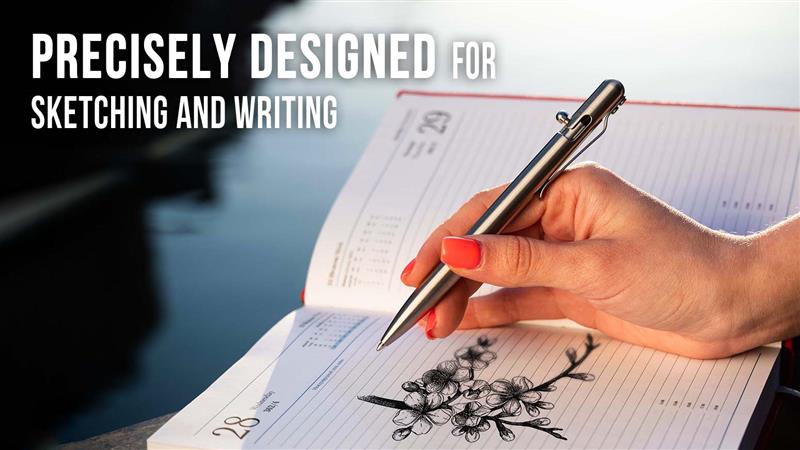
The Evolution of Pens: From Quills to Modern Precision Instruments
Mike NavitskyShare
In our modern world, where we go through an information overload on a fairly regular basis, we hardly ever stop to appreciate the early tools that made it possible for us to actually pass information down in a concise manner. For most of history, information was passed down verbally—until someone started to, instead, invent the written language and pass down this knowledge in a written manner, with no room for misunderstandings.
Starting from sharp rocks, going up to quills to now having performance gear like bolt action pens, the humble pen has come a long way. In this article, we’ll talk about this evolution.
It All Started with the Quill
Long before the mass-produced pens hit the scene, quills were used all over the writing world. These were made from bird feathers, usually from swan, turkey, or goose. Just for perspective, the quill was invented around 500 AD. All of Shakespeare’s work? Written by quills. The U.S. Declaration of Independence? Also written by quills.
How one uses a quill is by dipping its tip into an ink pot repeatedly, pulling it out and scribbling words on the paper. Now, this may seem quite fancy, but it isn’t tough to see how this can become a bit of a chore. However, despite all of its flaws, it is still used today because of how romanticized it is and how elegant it feels.
Enter the Fountain Pen
Now, let’s take a major jump to the 19th century. The fountain pen enters the scene with its built-in ink reservoir, and it was an absolute game-changer. It was like going from a bicycle to a superbike. Writers could now say goodbye to constant dipping and write out their thoughts uninterrupted for a long time. Writing suddenly became a much cleaner and smoother experience.
The fountain pen design was patented by Lewis Waterman in 1884 and became a staple for writers, journalists, and anyone that appreciated the art of writing across the world. It is still loved by folks today, largely due to the expressive feel it offers—something a ballpoint just cannot match.
The Ballpoint Boom
Alright, now let’s get to the 20th century—the era of mass production. It ushered in the cheap, disposable, yet convenient ballpoint pen. Patented by Hungarian-Argentinian journalist László Bíró in 1938. Arguably, no pen in the world had taken the world by storm as much as these pens. They used a tiny rotating ball to distribute ink evenly and without smudging.
What made it such a hit is, well, the fact that it was simple and affordable. Being so widely available, and affordable, meant students, professionals, and just individuals in general started using them all across the world. Instead of buying one good pen, people preferred stocking up on these.
While the ballpoint gave many individuals access to pens and introduced them to the art of writing, it also has one major downside: billions of them end up in landfills every year—and they, at least most of them, aren’t recyclable.
The Rise of the EDC & Bolt Action Pens
Many times, things happen at just the right time and end up contributing to a cause they perhaps weren’t even focused on. EDC pens gained massive popularity in the 90s and have been on the rise since. The EDC, or everyday carry, community takes inspiration from the military and works on the philosophy that one must carry with them objects of everyday use that are actually useful. EDC pens are thus designed to be reliable, rugged, and built to last—because, after all, if you’re going to be carrying something every day, it better be stylish as well as strong.
The bolt action pen became the face of the EDC community, appealing to everyone from minimalists to adventure junkies who value tools that last. It isn’t difficult to see why either.
The bolt action pen uses a bolt-style mechanism that takes inspiration from bolt-action rifles to extend and retract the writing tip. No misfires, no leaked ink, and extremely satisfying. These pens—specifically Bastion bolt action pens—are built from top-grade materials such as titanium, stainless steel, or carbon fiber. They’re made to last and are refillable. This means if the ink dries out, the cartridge can be replaced. The body is tough to damage thanks to these hard materials, but if a mechanism does go bad, it can also be replaced. This makes these pens quite an appealing choice for individuals who want to make an active effort toward reducing their carbon footprint.
Final Thoughts
The pen’s evolution is more than just tech—it’s about intention. We’ve gone from throwaway culture back to appreciating long-lasting, functional gear. The modern bolt action pen is a symbol of that shift: precise, refillable, built to stick around.
So next time you reach for a pen, maybe don’t settle for the cheap plastic kind. Think about the journey it took to get here. And maybe—just maybe—upgrade to something worthy of your signature.
FAQs
WHAT IS THE MAIN ADVANTAGE OF A BOLT ACTION PEN COMPARED TO A CLICK PEN?
The bolt mechanism offers more durability and a more tactile, satisfying action. It’s less prone to breaking and has a premium feel.
CAN I USE REGULAR INK REFILLS IN A BOLT ACTION PEN?
Many bolt action pens, like Bastion’s, are designed to accept standard Parker-style refills, making replacements easy and widely available.
ARE FOUNTAIN PENS STILL PRACTICAL TODAY?
Definitely. They’re favored by calligraphers, journaling fans, and anyone who enjoys a more fluid and expressive writing style.
